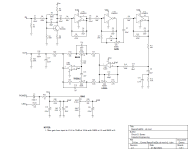Chuck D. Bones
Circuit Wizard
Did I spell that right? 
I've been thinking about this one for a long time. Glad I finally got around to building it because it sounds really good! I found two schematics on the 'net. One has four knobs: GAIN, BIAS, TONE & LEVEL. The other has six: GAIN, BIAS, BASS, MID, TONE & LEVEL. with the six-knob version, the MID control did very little and the BASS / MID tone stack ate too much signal. I saw an opportunity to add an active BASS control to the 4-knob circuit. Other than adding the BASS circuit, I altered five component values, all of them after the distortion stages. And I deleted the input buffer. Without buffered bypass, it's not really necessary and saves some parts. The BASS and TREBLE knobs are shown in their "flat" setting. Most of the parts are crowded around the Hitachi HD14069UB IC. The date code indicated that the year of manufacture ends in a 4. Is it 1984, 1994, 2004...?
Knobs (L-R): LEVEL - BASS - TREBLE - GAIN - BIAS

Build Docs Coming Soon...
I've been thinking about this one for a long time. Glad I finally got around to building it because it sounds really good! I found two schematics on the 'net. One has four knobs: GAIN, BIAS, TONE & LEVEL. The other has six: GAIN, BIAS, BASS, MID, TONE & LEVEL. with the six-knob version, the MID control did very little and the BASS / MID tone stack ate too much signal. I saw an opportunity to add an active BASS control to the 4-knob circuit. Other than adding the BASS circuit, I altered five component values, all of them after the distortion stages. And I deleted the input buffer. Without buffered bypass, it's not really necessary and saves some parts. The BASS and TREBLE knobs are shown in their "flat" setting. Most of the parts are crowded around the Hitachi HD14069UB IC. The date code indicated that the year of manufacture ends in a 4. Is it 1984, 1994, 2004...?
Knobs (L-R): LEVEL - BASS - TREBLE - GAIN - BIAS

Build Docs Coming Soon...
Last edited:







